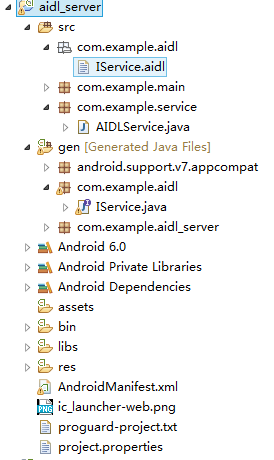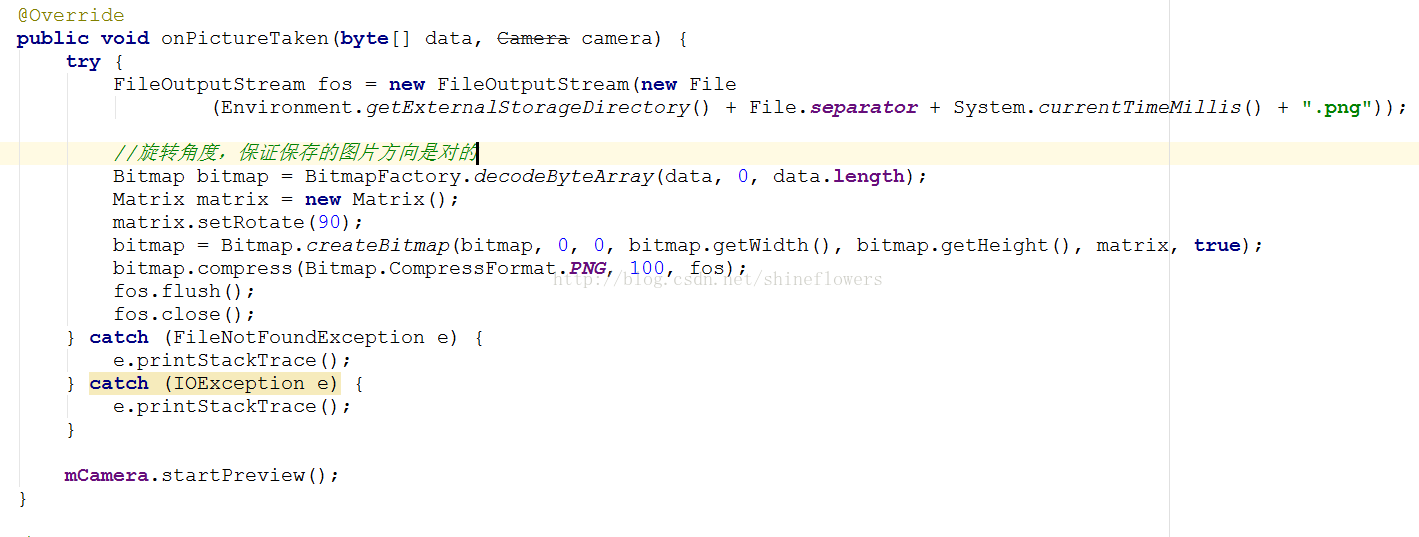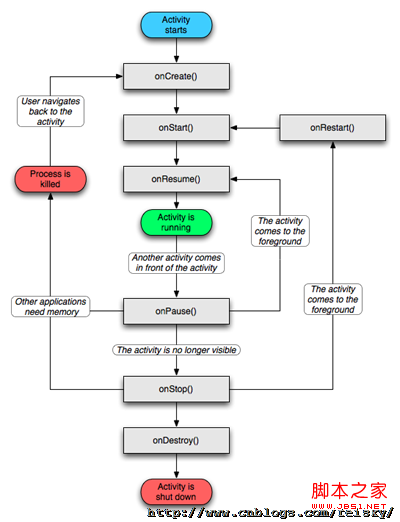編輯:關於Android編程
本文實例講述了android中圖形圖像處理之drawable用法。分享給大家供大家參考。具體如下:
一、如何獲取 res 中的資源
數據包package:android.content.res
主要類:Resources
其主要接口按照功能,劃分為以下三部分:
getXXXX()
例如:
int getColor(int id)
Drawable getDrawable(int id)
String getString(int id) 直接獲取res中存放的資源
InputStream openRawResource(int id) 獲取資源的數據流,讀取資源數據
void parseBundleExtras(XmlResourceParser parser, Bundle outBundle) 從XML文件中獲取數據
Resource為每種資源提供了相應的接口來獲取這種資源,除了可以直接獲取資源外,還額外提供了以數據流的方式獲取資源,這在以後的應用程序開發中會經常使用,那麼如何獲取Resources了,如下:Resources r = this.getContext().getResources();
二、如何獲取資源中的畫圖對象
數據包package:android.graphics.drawable
主要類:Drawable
Drawable是個virtual class,具體如何畫圖,需要具體分析Drawable的子類,例如:BitmapDrawable
其主要接口如下:
BitmapDrawable()
BitmapDrawable(Bitmap bitmap)
BitmapDrawable(String filepath)
BitmapDrawable(InputStream is)
void draw(Canvas canvas)
final Bitmap getBitmap()
final Paint getPaint()
Drawable是個抽象類,在BitmapDrawable中我們就看到位圖的具體操作,在仔細看下BitmapDrawable的構造函數,我們就會發現與Resource中的openRawResource()接口是相對應的,就可以通過以下方法來獲取位圖:
Resources r = this.getContext().getResources(); Inputstream is = r.openRawResource(R.drawable.my_background_image); BitmapDrawable bmpDraw = new BitmapDrawable(is); Bitmap bmp = bmpDraw.getBitmap();
Paint
數據包package:android.graphics
Android SDK中的簡介:The Paint class holds the style and color information about how to draw geometries, text and bitmaps. 主要就是定義:畫刷的樣式,畫筆的大小/顏色等。
Typeface
數據包 package:android.graphics
Android SDK中的簡介:The Typeface class specifies the typeface and intrinsic style of a font. 主要就是定義:字體。
核心類顯示資源
數據包package:android.graphics
主要類:Canvas
Android SDK中的簡介:The Canvas class holds the “draw” calls. To draw something, you need 4 basic components: A Bitmap to hold the pixels, a Canvas to host the draw calls (writing into the bitmap), a drawing primitive (e.g. Rect, Path, text, Bitmap), and a paint (to describe the colors and styles for the drawing).
按照結構的功能,將主要接口分為以下3部分:
boolean clipXXXX() Region區域操作:DIFFERENCE INTERSECT REPLACE REVERSE_DIFFERENCE UNION XOR
void drawXXXX()畫圖函數
void rotate() void scale() void skew() void translate() 畫布操作函數
Region在這裡需要特殊說明下:Region就是一個區域,也就是畫布(Canvas)中的有效區域,在無效區域上draw,對畫布沒有任何改變。
Drawable類
Drawable是一個通用的抽象類,它的目的是告訴你什麼東西是可以畫的。你會發現基於Drawable類擴展出各種繪圖的類,見下面的表格,當然你可以繼承它來創建你自己的繪圖類.
有三種方法可以定義和實例化一個Drawable:保存一個圖片到你工程資源中,使用XML文件來描述Drawable屬性或者用一個正常的類去構造。下面我們將討論兩種技術(對一個有開發經驗的開發者來說構造並不是最新的技術)。
從資源圖像文件中創建
一個比較簡單的方法是添加一個圖片到你的程序中,然後通過資源文件引用這個文件,支持的文件類型有PNG(首選的) JPG(可接受的)GIF(不建議),顯然這種對於顯示應用程序的圖標跟來說是首選的方法,也可以用來顯示LOGO,其余的圖片可以用在例如游戲中。
把一個圖片資源,添加你的文件到你工程中res/drawable/目錄中去,從這裡,你就可以引用它到你的代碼或你的XML布局中,也就是說,引用它也可以用資源編號,比如你選擇一個文件只要去掉後綴就可以了(例如:my_image.png 引用它是就是my_image)。
注意:SDK指出,為了縮小圖片的存儲空間,在Build的時候又可能對圖片進行壓縮,如果不想被壓縮,可以將圖片放在res/raw/目錄中。
SDK給出的例子:
LinearLayout mLinearLayout;
protected void onCreate(Bundle savedInstanceState) {
super.onCreate(savedInstanceState);
// Create a LinearLayout in which to add the ImageView
mLinearLayout = new LinearLayout(this);
// Instantiate an ImageView and define its properties
ImageView i = new ImageView(this);
i.setImageResource(R.drawable.my_image);
i.setAdjustViewBounds(true); // set the ImageView bounds to match the Drawable's dimensions
i.setLayoutParams(new Gallery.LayoutParams(LayoutParams.WRAP_CONTENT, LayoutParams.WRAP_CONTENT));
// Add the ImageView to the layout and set the layout as the content view
mLinearLayout.addView(i);
setContentView(mLinearLayout);
}獲取Drawable對象:
Resources res = mContext.getResources();
Drawable myImage = res.getDrawable(R.drawable.my_image);
注意:保持每個資源類型的一至,可以保證你項目狀態的一致性,就不用擔心有許多不同類型的對象來實例化它。例如:如果使用相同的圖像資源來實例化兩個Drawable對象。然後修改一個Drawables的屬性(例如alpha),然後不幸得是這個效果也會出現在另一個對象上去。所以當處理同一個資源的多個實例對象時,不是直接轉換為Drawable,而是應該執行tween animation
如何添加資源到ImageView:
<ImageView android:layout_width="wrap_content" android:layout_height="wrap_content" android:tint="#55ff0000" android:src="@drawable/my_image"/>
從XML文件中創建
到如今,你應該比較熟悉按Android的原則去開發一個用戶接口,因此,你也應該理解了定義一個XML文件對於對象的作用與靈活的重要性。這個理念無數次用於Drawables.
如果你想創建一個Drawable對象,而這個對象並不依賴於變量或用戶的交換,把它定義到XML中去應該是一個不錯的方法。即使你期望在你的應用程序中改變其屬性來增加用戶體驗。你應該考慮把對象放入XML中,因為你可以隨時修改其屬性。
當你在你的XML中定義了一個Drawable,保存這個XML文件到你工程目錄下res/drawable目錄中,然後通過調用Resource.getDrawable()來檢索並實例化,傳遞給它XML文件中的資源ID號。任何Drawable的子類都支持inflate這個方法,這個方法會通過XML來實例化你的程序。任何Drawable都支持XML的擴展來利用特殊的XML屬性來幫助定義對象的屬性,可以查看任何Drawable子類文檔來看如何定義XML文件。
如下定義了一個TransitionDrawable:An extension of LayerDrawables that is intended to cross-fade between the first and second layer. It can be defined in an XML file with the <transition> element. Each Drawable in the transition is defined in a nested <item>. 有關TransitionDrawable的詳細信息查看http://androidappdocs.appspot.com/reference/android/graphics/drawable/TransitionDrawable.html。
將其定義在res/drawable/expand_collapse.xml:
<?xml version="1.0" encoding="utf-8"?> <transition xmlns:android="http://schemas.android.com/apk/res/android"> <item android:drawable="@drawable/pic1"/> <item android:drawable="@drawable/pic2"/> </transition>
下面實例化並處理:
public class MainActivity extends Activity {
/** Called when the activity is first created. */
@Override
public void onCreate(Bundle savedInstanceState) {
super.onCreate(savedInstanceState);
setContentView(R.layout.main);
Resources res=getResources();
TransitionDrawable trans=(TransitionDrawable )res.getDrawable(R.drawable.expand_collapse);
ImageView image = (ImageView)findViewById(R.id.ImageView01);
image.setImageDrawable(trans);
trans.startTransition(3000);
}
}ShapeDrawable
當你想去畫一些動態的二維圖片,一個ShapeDrawable對象可能會對你有很大的幫助。通過ShapeDrawable,你可以通過編程畫出任何你想到的圖像與樣式。
ShapeDrawable繼承了Drawable, 所以你可以調用Drawable裡有的函數,比如視圖的背景,通過setBackgroundDrawable()設置。當然,你可以在自定義的視圖布局中畫你的圖形,因為ShapeDrawable有自己的draw()方法。你可以在View.OnDraw()方法期間創建一個視圖的子類去畫ShapeDrawable。
ShapeDrawable類(像很多其他Drawable類型在android.graphics.drawable包)允許你定義drawable公共方法的各種屬性。有些屬性你可以需要調整,包括透明度,顏色過濾,不透明度,顏色。
NinePatchDrawable
NinePatchDrawable 繪畫的是一個可以伸縮的位圖圖像,Android會自動調整大小來容納顯示的內容。一個例子就是NinePatch為背景,使用標准的Android按鈕,按鈕必須伸縮來容納長度變化的字符
NinePatchDrawable是一個標准的PNG圖像,它包括額外的1個像素的邊界,你必須保存它後綴為.9.png,並且保持到工程的res/drawable目錄中。
這個邊界是用來確定圖像的可伸縮和靜態區域。你可以在左邊和上邊的線上畫一個或多個黑色的1個像素指出可伸縮的部分(你可以需要很多可伸縮部分),它的相對位置在可伸縮部分相同,所以大的部分總是很大的。
你還有可以在圖像的右邊和下邊畫一條可選的drawable區域(有效的,內邊距線)。如果你的視圖對象設置NinePath為背景然後指定特殊的視圖字體,它將自行伸縮使所有的文本來適應根據右線與底部線設計好的區域(如果有的話),當然內邊距線不包括其中,Android可以使用左邊的線與上面的線來定義一個drawable區域。
我們來澄清一下這兩條不同的線,左邊跟頂部的線來定義哪些圖像的像素允許在伸縮時被復制。底部與右邊的線用來定義一個相對位置內的圖像,視圖的內容就放入其中。
希望本文所述對大家的Android程序設計有所幫助。
 [Android] AIDL的使用情況和實例介紹
[Android] AIDL的使用情況和實例介紹
AIDL是什麼? AIDL (Android Interface Definition Language), Android接口定義語言,Android提供的IPC (
 Android自定義相機實現定時拍照功能
Android自定義相機實現定時拍照功能
這篇博客為大家介紹Android自定義相機,並且實現倒計時拍照功能。首先自定義拍照會用到SurfaceView控件顯示照片的預覽區域,以下是布局文件:activity_m
 Android 自定義View需要重寫ondraw()等方法
Android 自定義View需要重寫ondraw()等方法
Android 自定義View需要重寫ondraw()等方法,這篇博客給大家說說自定義View的寫法,需要我們繼承View,然後重寫一些 方法,方法多多,看你需要什麼方
 android生命周期深入分析(二)
android生命周期深入分析(二)
在 Android 中,多數情況下每個程序都是在各自獨立的 Linux 進程中運行的。當一個程序或其某些部分被請求時,它的進程就“出生”了;當這個程序沒有必要再運行下去且